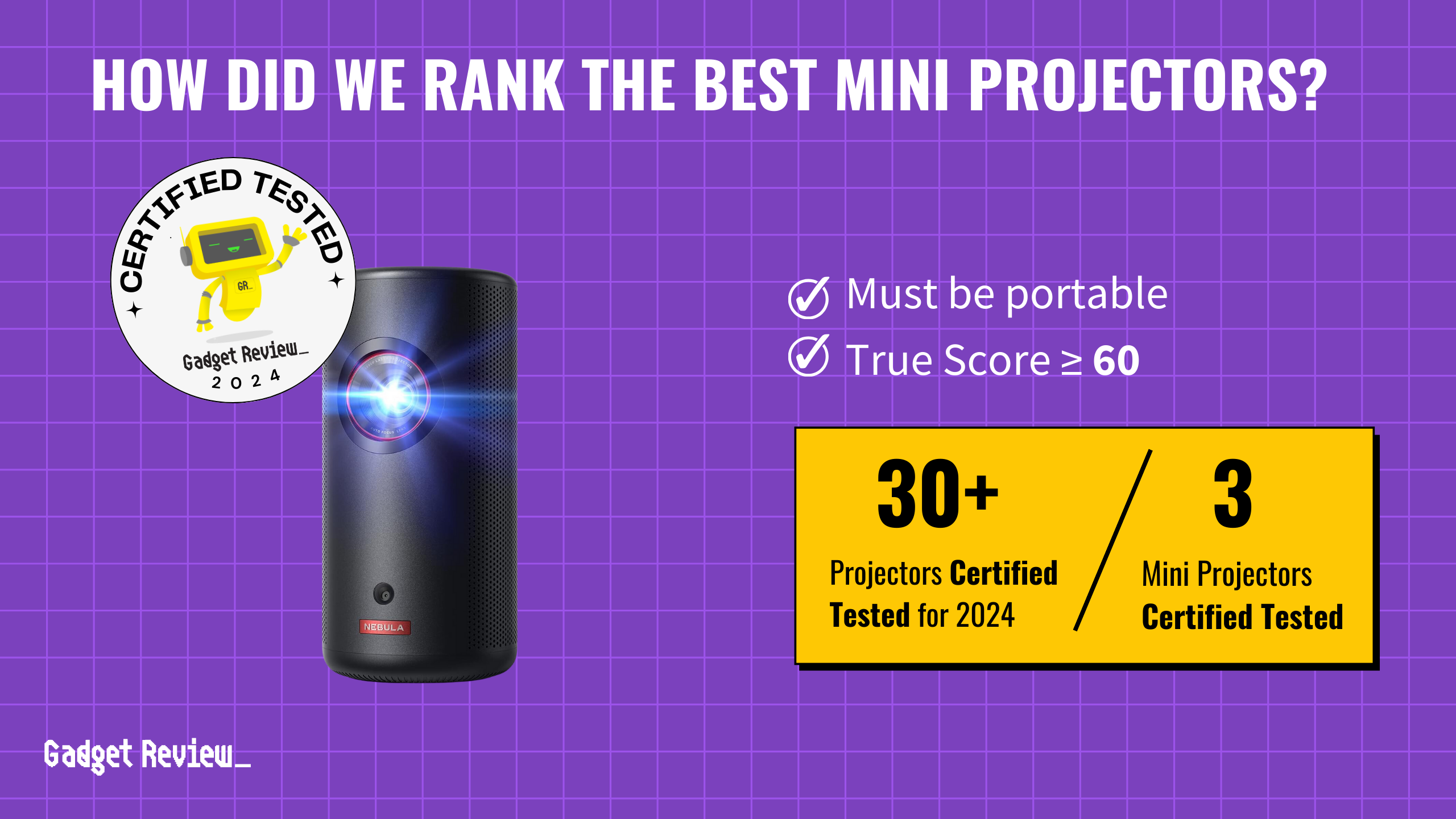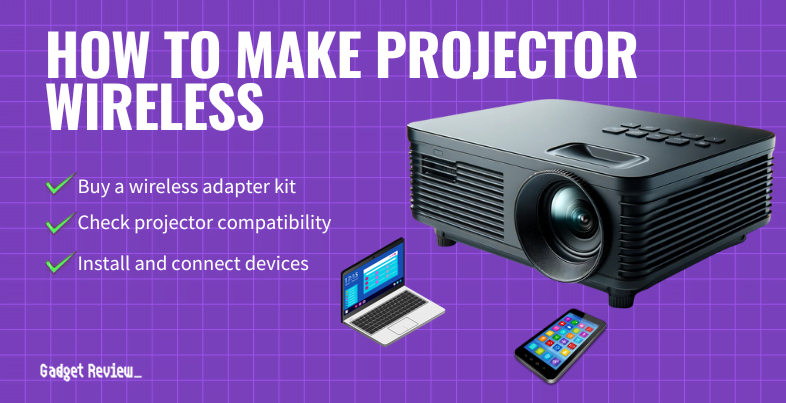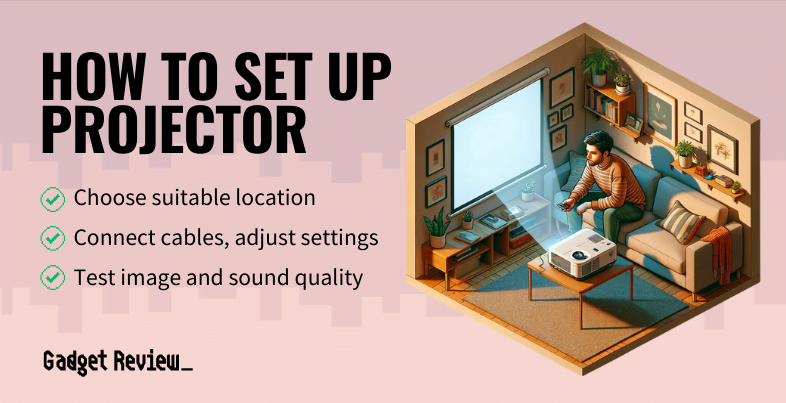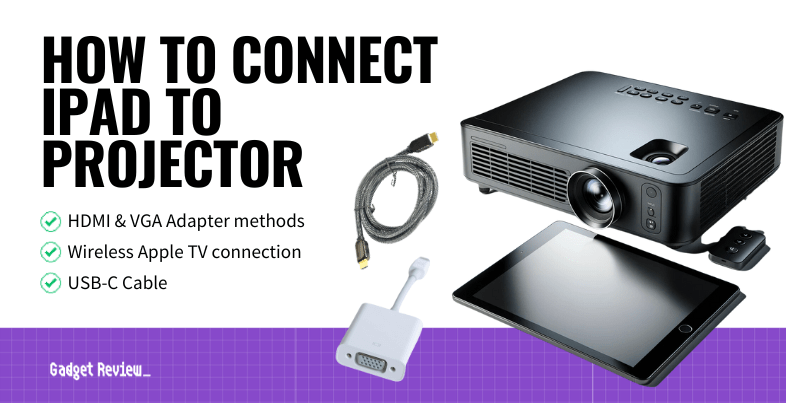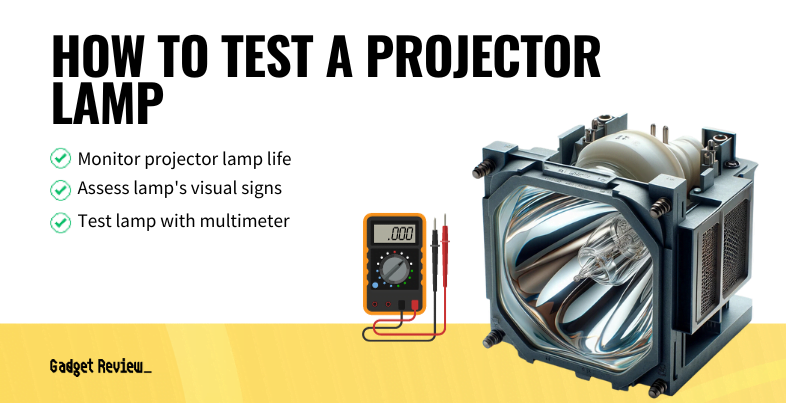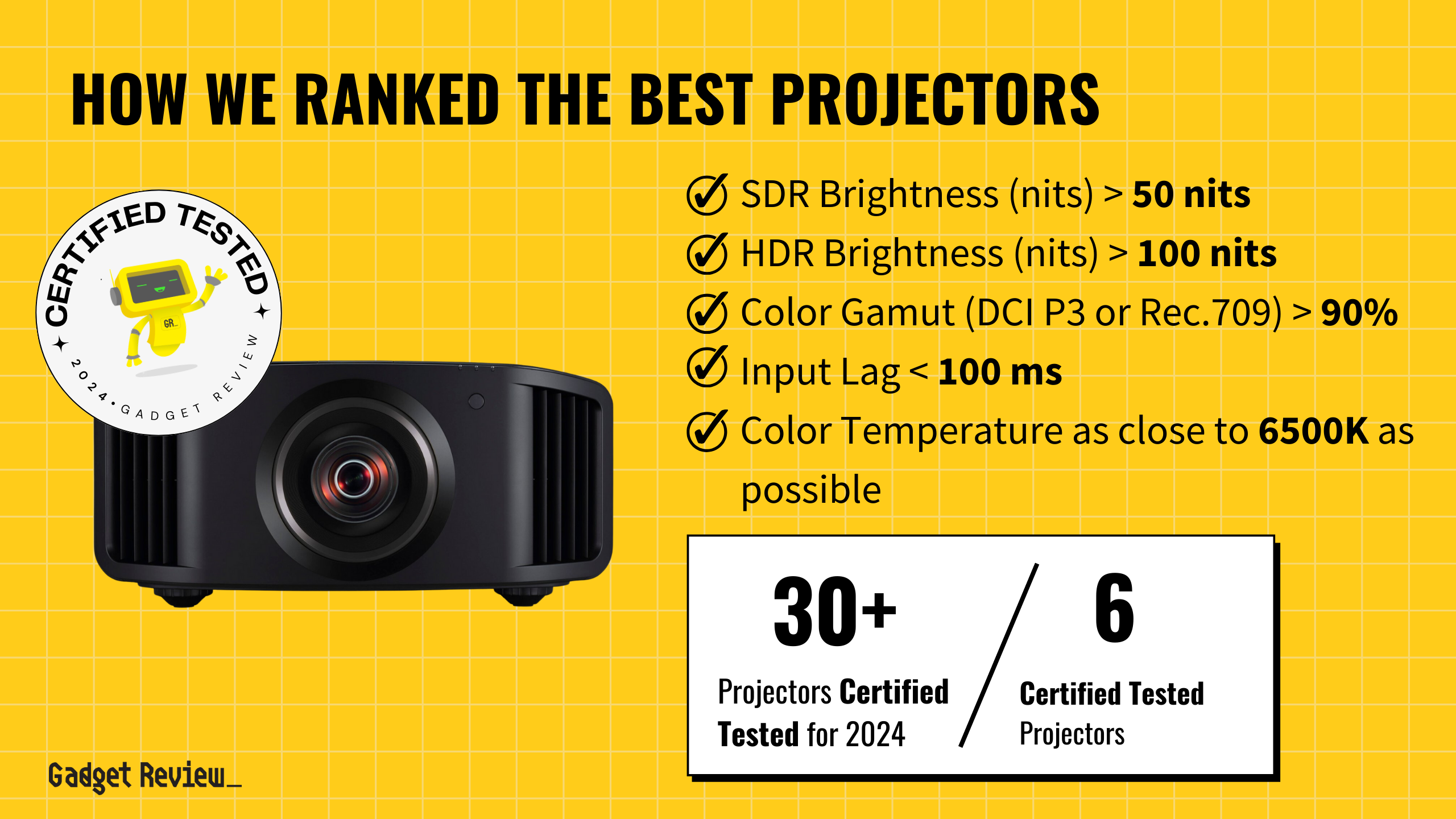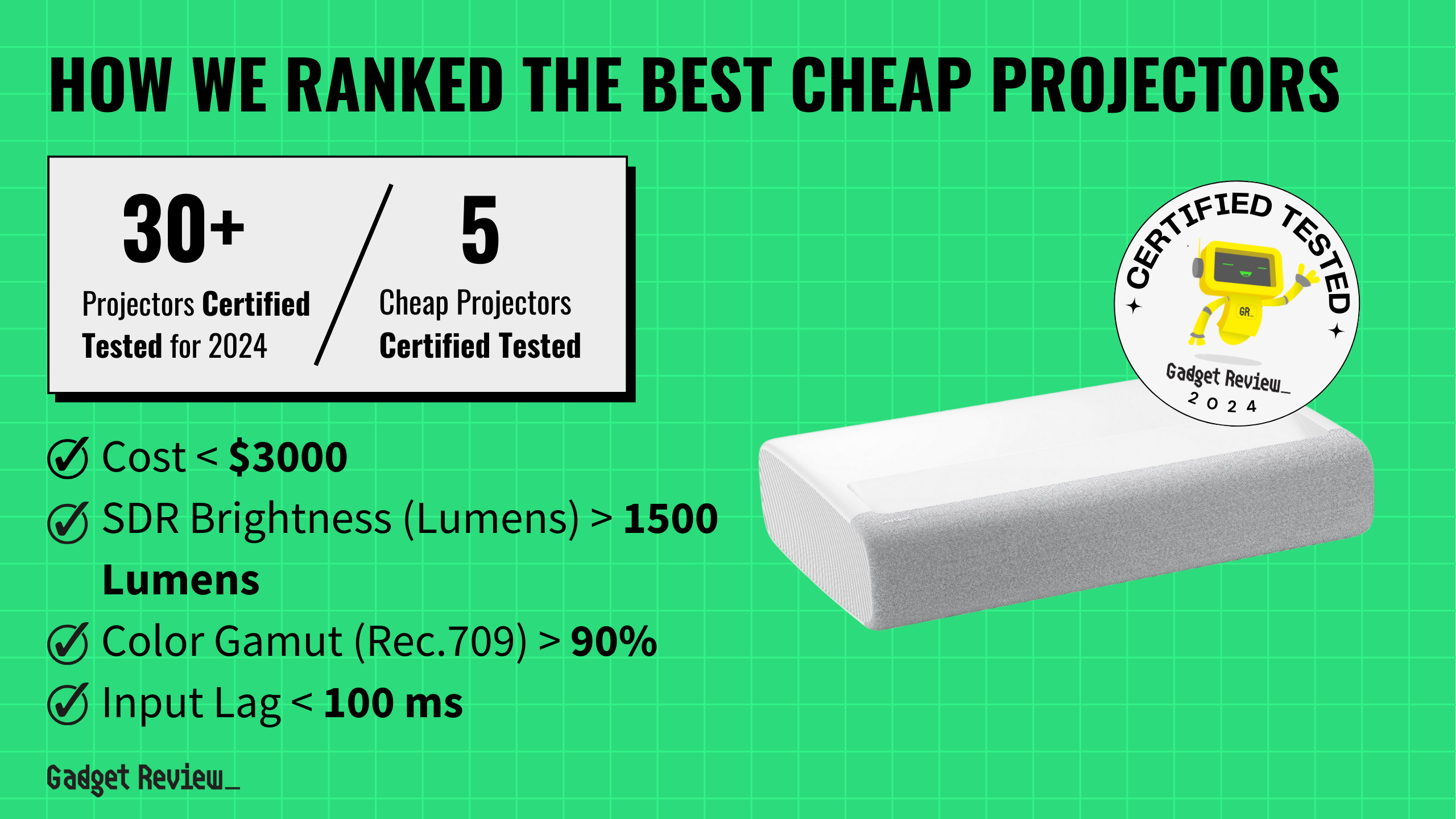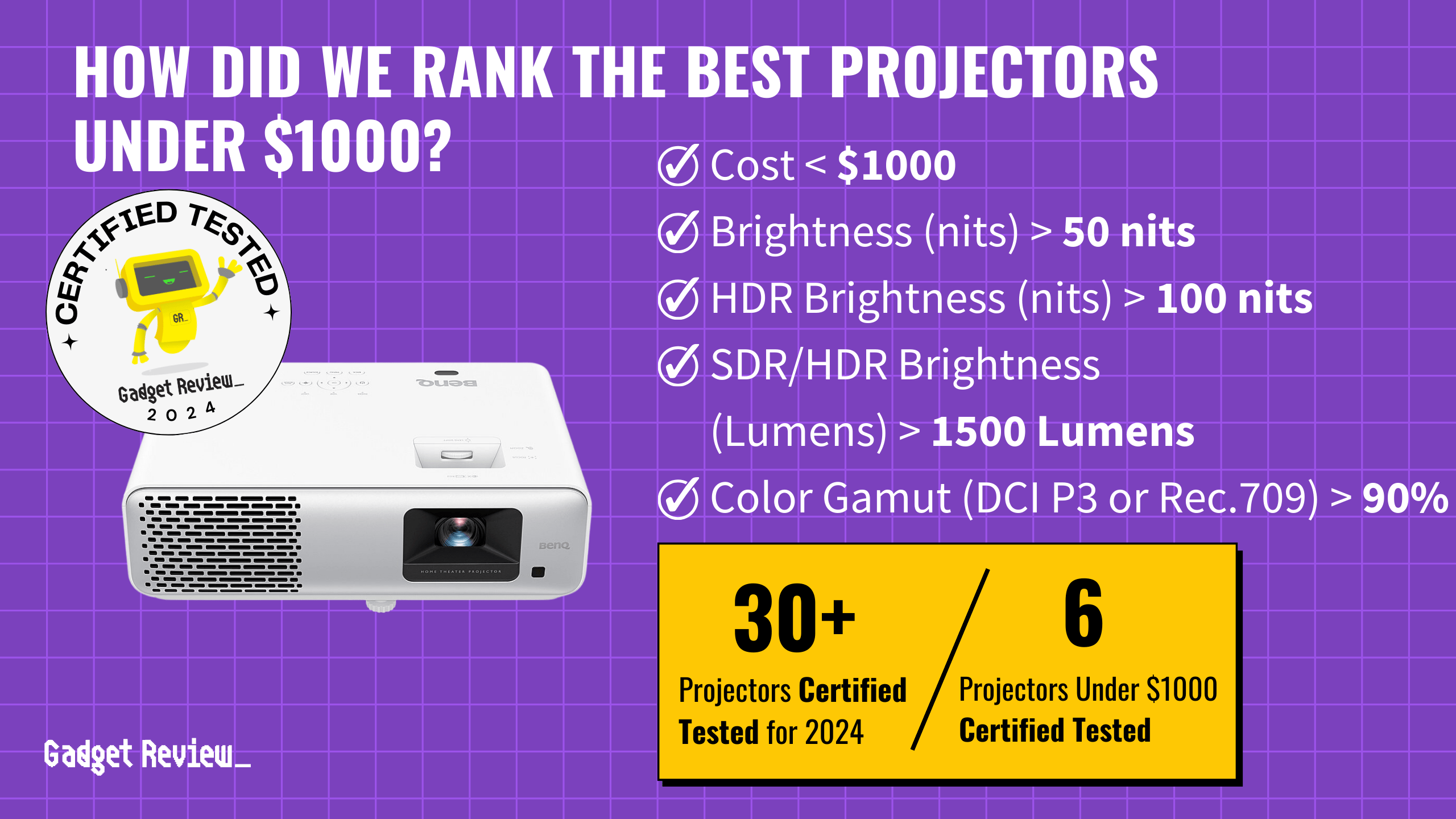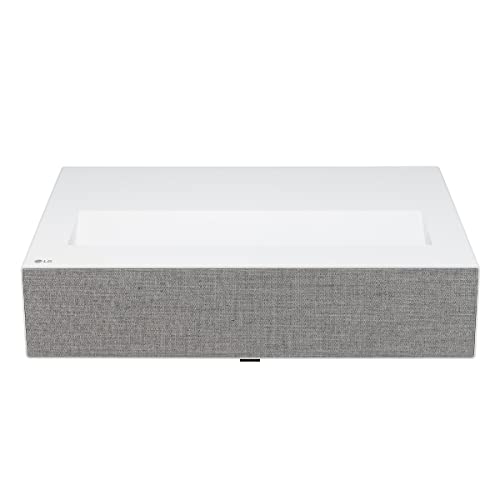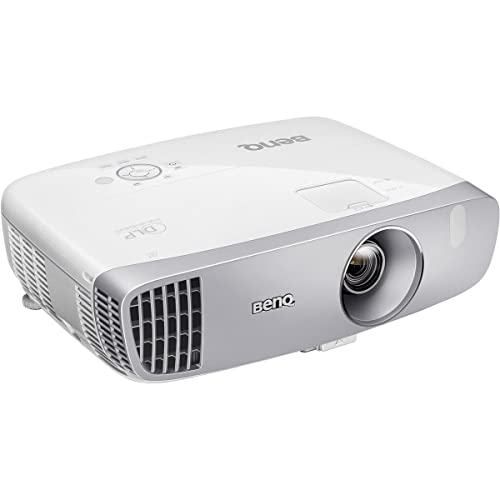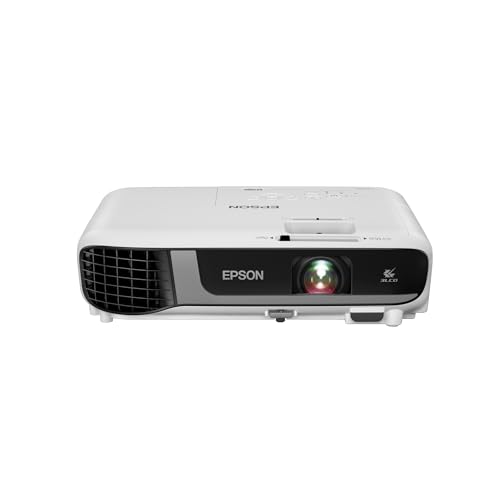A portable mini projector is a game-changer for streaming videos on your phone, giving you that big TV experience without the bulky setup. When hunting for the perfect mini projector, you want something portable and versatile without skimping on performance. In our latest guide, three mini projectors stood out from 30 evaluated, thanks to their excellent image quality, brightness, and ease of use.
We analyzed 10,297 reviews and certified these models as tested. Our process included filtering out fake and low-quality reviews. Using our data derived True Score, we ensured only the quality projectors that performed well in testing made the cut, offering you reliable and high-performing mini projectors.
How Did We Rank the Best Mini Projectors?
Gadget Review’s guide to the best mini projectors stems from an in-depth review of over 200 sites, examining testing methods and customer feedback. Our team focused on understanding the critical aspects of performance and usability. The result? A list of top projectors defined by 1 must-have specification. This structured approach guarantees that our recommendations meet the highest quality and user satisfaction standards.
Our commitment to unbiased reviews is powered by our ‘True Score’ system, targeting low quality and fake reviews. When you shop through our links, you’re backing our mission. Dive deeper to see how.
?️ Minimum Specifications
- Must be a small form factor or “mini” projector.
Latest Updates
- 05/15/2024: Published the list of best mini projectors based on our True Score system.
Top Best Mini Projectors For 2025
Prices accurate at the time of publishing

Best Overall

Runner Up

Best Value

Best Budget

Best Mid-Range

Premium Pick
Anker Capsule 3
The Anker Capsule 3 combines portability with a large screen capacity, delivering over 120 inches of display. Ideal for diverse outdoor settings, its 1080p resolution and extensive connectivity make it a versatile choice, albeit at a higher price.
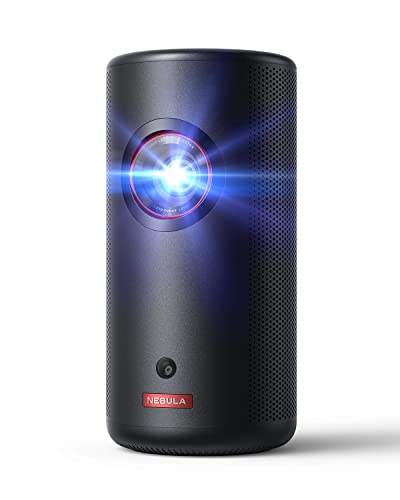
True Score
73748Experts
76439Customers
Mixed Reviews
 $749.99
$749.99Read More
Snapshot
Reasons to Buy
- Good image quality for size
- Reasonably low input lag
Reasons to Avoid
- Poor brightness levels
- No Netflix app
Specifications

Resolution 1920 x 1080 (Full HD) Refresh Rate 60 Hz 
Display Technology DLP 
Contrast Ratio 500:1 
Digital Keystone Yes 
HDR Yes 
Max Distance n/a 
Max Screen Size 120″ 
3D Ready No 
Aspect Ratio 16:9 
Brightness 300 ANSI Lumens 
Depth 6.5″ 
HDMI Type HDMI 2.1 
Height 6.7″ 
Integrated Speakers Yes 
Light Source Laser 
Light Source Life 30,000 hrs 
Min Distance n/a 
Min Screen Size 60″ 
Noise Level 32 dB 
Portable Yes 
Smart Functionality Android TV, Bluetooth, Google Assistant, Google Cast, Remote, Wi-Fi 
Sync Technology n/a 
TV Tuner No 
ThrowType Short Throw 
Video Inputs HDMI, USB 
Weight 2.1 lbs 
Width 3.2″ All Specs
Test Results
SDR Brightness (Lumens) 175 Contrast Ratio (x:y) 138 Input Lag (ms) 22 Color Gamut % (Rec. 709) 92 Color Gamut % (DCI P3 uv) 75 Color Gamut % (Rec. 2020) 56 SDR Color Temperature (K) 6,863 All Retailers
- $749.99
- $799.99
Our Verdict
The Anker Capsule 3 is a portable projector that delivers a surprising screen size despite its small form factor. Reaching a maximum screen size of over 120 inches it’s a great way to get a huge screen showing video just about anywhere. The Capsule outputs 1080p resolution at a 16:9 aspect ratio, good enough for most standard content, if a bit limited. Given the portable nature of the Capsule, the reduced resolution isn’t a surprise, though given the high price tag, it is a bit of a letdown.
Equipped with smart functionality, the Anker Capsule 3 offers direct access to streaming services via built-in apps, eliminating the need for additional streaming devices. Its connectivity is enhanced by multiple ports, including HDMI and USB, which accommodate a wide range of external devices from gaming consoles to mobile phones, making it an excellent choice for streaming high-definition content, including video games and live sports.
Despite its small stature, the Anker Capsule 3 is designed for performance. Its compact and lightweight design does not compromise on power, making it easy to transport and capable of delivering superior projection quality. This makes it an attractive option for those who value mobility and functionality in their entertainment setups.
Read Less

DON’T SEE WHAT YOU’RE LOOKING FOR?
Check out our guide on the top projectors under $1000 for high-quality options within your budget. For educational settings, explore our selection of the best projectors for classrooms. If you’re looking for affordability, discover our recommendations for the best cheap projectors.

Best Overall

Runner Up

Best Value

Best Budget

Best Mid-Range

Premium Pick
Kodak Luma 350
Ultra-compact and cost-effective, the Kodak Luma 350 maximizes portability without sacrificing screen size, offering up to 150 inches of display. It is perfect for mobility-focused users, though its upscaled 1080p resolution may not satisfy all high-quality video needs.
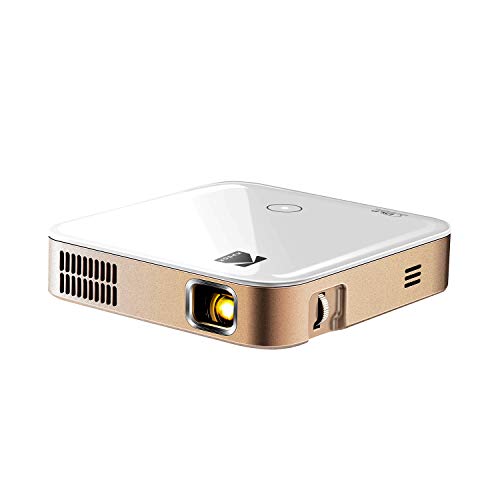
True Score
71724Experts
752kCustomers
Mixed Reviews
 SAVE $50$349.99$299.99
SAVE $50$349.99$299.99Read More
Snapshot
Reasons to Buy
- Exceptional portability
Reasons to Avoid
- Average brightness
- Average image quality
- Prone to rainbow artifacts
Specifications

Resolution 1920 x 1080 (Full HD) Refresh Rate 60 Hz 
Display Technology DLP 
Contrast Ratio 3500:1 
Digital Keystone No 
HDR Yes 
Max Distance n/a 
Max Screen Size 200″ 
3D Ready n/a 
Aspect Ratio 16:9 
Brightness 350 lumens 
Depth 4.5″ 
HDMI Type 2.0 
Height 1.25″ 
Integrated Speakers Yes 
Light Source LED 
Light Source Life 20000 hrs 
Min Distance n/a 
Min Screen Size 40″ 
Noise Level 30 dB 
Portable Yes 
Smart Functionality Android TV, Bluetooth, Remote, USB 
Sync Technology n/a 
TV Tuner No 
ThrowType Short Throw 
Video Inputs HDMI 2.0, USB 
Weight 0.72 lbs 
Width 4.45″ All Specs
Test Results
SDR Brightness (Lumens) 129 Contrast Ratio (x:y) 130 Color Gamut % (Rec. 709) 96 SDR Color Temperature (K) 8,855 Color Gamut % (Rec. 2020) 61 All Retailers
- $299.99$350Save $50
Our Verdict
If you want the smallest possible projector that still outputs a respectable amount of screen real estate, the Kodak Luma 350 offers a screen size of up to 150 inches in an impressively tiny and inexpensive package. Weighing just 0.72 lbs and standing only 1.25 inches tall, it’s one of the most compact projectors on the market, ideal for on-the-go presentations and outdoor movie sessions.
Resolution is where the projector makes its biggest compromise – it outputs upscaled 1080p, which is good enough for most content you’d reasonably be putting out of such a tiny projector, like presentations or movies, but it’s not ideal if you want high-quality video. It’s more expensive and larger, but the Anker Capsule 3 natively outputs 1080p for better overall image quality if that’s your concern.
The Kodak Luma 350 features a useful built-in Android system that makes direct streaming from popular apps a breeze by reducing the need for external inputs and connections. This does mean you lose a few of the less common connectors, but the projector has HDMI 2.0 support, and given how common HDMI is, it should be enough for most cases. Additionally, its LED light source promises a long lifespan of up to 30,000 hours, offering reliability and reduced maintenance over its lifetime.
The Kodak Luma 350 excels when space and power are limited or when mobility and convenience are needed. Its design and features make it a strong contender for anyone needing a lightweight, versatile projector capable of adapting to casual and professional environments.
Read Less
Category Snapshot
Projectors
- Total Brands/Products Tested
11 Brands, 30 Products
- Top 2 Brands
Epson, BenQ
- Price Range (Budget-Premium)
$350-$16,000
- Average True Score
81.36
- Important Test Criteria
Brightness (cd/m2)
Contrast Ratio (1000:1) - Most Trusted Testers

- Top Projector Experts
- Typical Warranty
1 year
- Covered by Insurance
Yes – AKKO

Best Overall

Runner Up

Best Value

Best Budget

Best Mid-Range

Premium Pick
Optoma ML1080
Optoma ML1080 blends robust performance with portability, supporting 1080p and 3D content across a 100-inch display. Ideal for varied lighting conditions, it provides comprehensive connectivity and long-term reliability, suitable for both leisure and professional use.
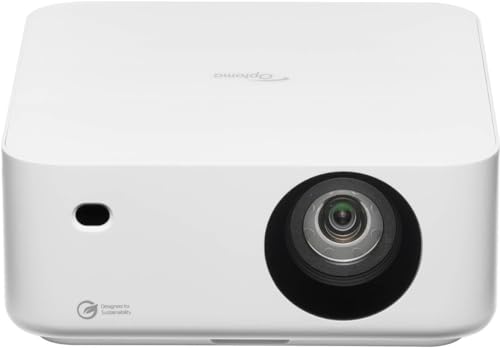
True Score
71722Experts
74294Customers
Mixed Reviews
 SAVE $187$989.00$802.06
SAVE $187$989.00$802.06Read More
Snapshot
Reasons to Buy
- Impressive brightness rating
- High image quality
Reasons to Avoid
- No support for digital keystone correction
- No support for lens shift adjustment
Specifications

Resolution 1920 x 1080 (Full HD) Refresh Rate 60 Hz 
Display Technology DLP 
Contrast Ratio 3,000,000:1 
Digital Keystone Yes 
HDR HDR10, Hybrid Log-Gamma (HLG) 
Max Distance 104.6″ 
Max Screen Size 100″ 
3D Ready No 
Aspect Ratio 16:9 
Brightness 1200 Lumens 
Depth 5.3″ 
Height 2.6″ 
Integrated Speakers Yes 
Light Source Laser 
Light Source Life 30,000 hrs 
Min Distance 62.75″ 
Min Screen Size 59.84″ 
Noise Level 28 dB 
Portable Yes 
Smart Functionality Eco-Friendly, Energy-Saving 
Sync Technology – 
TV Tuner No 
ThrowType Short Throw 
VRR n/a 
Video Inputs USB 
Weight 2.2 lbs 
Width 6.18″ Yes – All Specs
Test Results
SDR Brightness (Lumens) 586 Input Lag (ms) 25 Color Gamut % (BT.2020) 105 All Retailers
- $802.06$989Save $187
- $845.87
- $1,023.32$1,749Save $726
Our Verdict
The Optoma ML1080 offers an impressive blend of performance and portability, but this comes at a premium price. This projector supports a native 1080p resolution, ensuring sharp and detailed images essential for movies and presentations. The inclusion of 3D content support is also welcome, letting you enjoy 3D films and content when you’re out and about.
One drawback is the maximum size—the projector can only reach 100 inches. If you need the most screen real estate possible, the Kodak Luma 350 will be a better pick, but you’ll have to compromise on image quality since it doesn’t output true HD. The brightness level on the ML1080 is good; at 1000 ANSI lumens, it delivers clear and vivid projections, making it suitable for a variety of settings both indoors and outdoors where ambient light isn’t controllable.
The ML1080 is bulkier than the similarly shaped Luma, but the extra bulk isn’t wasted. It offers a range of connectivity options, including HDMI and MHL, accommodating various devices such as laptops, smartphones, and gaming consoles, which are particularly useful for presentations and entertainment. Moreover, the Optoma ML1080’s lamp life extends to 20,000 hours, minimizing maintenance needs and ensuring long-term reliability.
The ML1080 is designed for users who need a balance of high-quality display, durability, and ease of transport, making it an excellent choice for both personal and professional use. It’s expensive, but it’s also the most robust in overall features, offers the most connectivity, and is 3D-ready to handle a wide range of content.
Read Less
Which Criteria Matters for Testing Best Mini Projectors?
By focusing on these criteria, anyone can quickly and easily compare these projectors and how they’ll perform. This helps you make an informed decision and purchase a projectors that will meet your needs.
| CRITERIA | RANGE | REQUIRED | DEFINITION |
|---|---|---|---|
| SDR Brightness (lumens) | > 1000 lumens | Yes | The amount of light the projector outputs from the lamp/bulb and projects onto the screen when playing SDR content. |
| HDR Brightness (lumens) | > 2000 lumens | No (Nice to have) | The amount of light the projector outputs from the lamp/bulb and projects onto the screen when playing HDR content. |
| Contrast Ratio | > 2000:1 | Yes | The difference between the brightest white and darkest black that a projector can produce, expressed as a ratio. |
| Color Gamut % (DCI P3) | > 90% | No (Nice to have) | The % of colors a projector can produce defined by the gamut. DCI-P3 is commonly used in film. |
| Color Gamut % (Rec. 709) | > 90% | No (Nice to have) | The % of colors a projector can produce defined by the gamut. Rec. 709 is commonly used by HD TV, and is also known as BT.709. |
| Color Gamut % (Rec. 2020) | > 70% | No (Nice to have) | The % of colors a projector can produce defined by the gamut. Rec.2020 is commonly used by UHD TV content, as well as HDR content. It is also known as BT.2020. |
| Input Lag | < 40 ms | No (Nice to have) | The amount of time it takes for inputs to be registered and processed by the projector and shown on screen. |
Our Trusted Data Sources
We looked at 86+ projector reviewers and found that 16 are trustworthy (60%+ Trust Rating). The three we have listed below are our most trusted for projector.
- Pierre-Olivier Jourdenais – Rtings, LinkedIn
- Geoffrey Morrison – CNET, MuckRack
- Kam Valentine – Projector Reviews, MuckRack
Interested in a comprehensive analysis of our data sources? We’ve got you covered. Below, you’ll find a detailed list of every projector review website we’ve identified, organized by their respective Trust Ratings from highest to lowest. But we didn’t stop there. We’ve meticulously reviewed each publication and verified the data by checking whether the authors have bio links to MuckRack or LinkedIn. We’re committed to not only checking the facts but ensuring their veracity.
Projector Specifications, Test Data & Results
Disclaimer:
Projectors are complex and difficult to test and evaluate, requiring extensive testing on the same level as televisions to paint a complete picture of how any given unit performs. Unfortunately, the testing behind projectors isn’t as rigorous, and a lot of the data we’ve compiled from expert reviewers has been incomplete at times. With different brightnesses measured from different sources, different color gamut tested and spotty contrast ratio measurements, we’ve done the best we can to leverage the available data when putting together these lists but have also trusted our True Score to help us make decisions when the data isn’t available.
1. Brightness (Lumens) Specifications
Brightness (Lumens)
Definition: The amount of light the projector outputs from the lamp/bulb and projects onto the screen when playing SDR content, measured in lumens.
Units of Measurement: Lumens
Tools to Measure: Lux meter
Why It’s Important:
Lumens affect how an image is going to look when projected on a screen. If the projector isn’t putting out enough light, the image quality will suffer.
Projectors have two ways you can realistically measure brightness: in lumens or in nits. Lumens are more common, but brightness in general matters because projectors have to project light strongly enough that it overcomes ambient light without losing detail or color.
Most of the time, a projector is going to be used in a fairly dark room to help give the unit the best chance of displaying content the way it was intended, but higher lumens output let you watch content in progressively bright spaces – or across longer distances on bigger screens. For standard dynamic range content, we recommend at least 1000 lumens for most home applications, but more isn’t a bad thing, and 3000 lumens or more are ideal.
Brightness (Lumens; higher is better; 0 = No Data)
2. Height Specifications
Mini projectors have to actually be “portable”mini”, and one way to confirm that is by looking at the measurements of the projector. Height gives you a decent idea of where you can set a projector, particularly if you want to stow it in a bag or place it on a set of shelves.
We don’t have a specific recommended size for height; you simply need the projector be short enough to suit your needs, which varies depending what kind of storage solution you have for the projector.
Height
Definition: The physical height of the projector.
Units of Measurement: ” (inches)
Why It’s Important:
If a projector is too tall, you’ll have difficulty putting it in tight places, which defeats the purpose of buying a “mini” projector.
Height (Inches; 0 = No Data)
3. Width Specifications
Width
Definition: The physical width of the projector.
Units of Measurement: ” (inches)
Why It’s Important:
If a projector is too wide, you’ll have difficulty putting it in tight places, which defeats the purpose of buying a “mini” projector.
Width is just as important as height when it comes to mini projectors. Get too wide and you’ll run into significant issues with being able to place the projector wherever you want, which is the whole point of getting a mini projector.
We don’t have a recommended size for width; you just need the projector to have a small enough footprint that you can put it wherever you want to or need to.
Width (Inches; 0 = No Data)
4. Noise Level Specifications
Projectors make noise when they’re running, and if the noise level is high, it’s going to start cutting into the content you’re watching. This is distracting, so the quieter a projector can run, the better.
That said, there’s no real “ideal” noise level for your projector, it just shouldn’t exceed 40 dB. For reference, a typical conversation is about 60 dB.
Noise Level
Definition: The amount of noise the projector makes under normal operation.
Units of Measurement: dB (Decibels)
Why It’s Important:
If a projector is loud, it’ll start to distract you when watching movies, especially during quite moments.
Noise Level (dB; 0 = No Data)
5. Maximum Screen Size Specifications
Maximum Screen Size
Definition: The largest screen size a projector can effectively produce without losing focus or quality.
Units of Measurement: ” (inches)
Why It’s Important:
If you have a wall and/or a very large screen that you want filled up with as large an image as possible, maximum screen size is how you fill it up.
Projectors can produce images of varying sizes, and the maximum screen size is as the name suggests: the maximum size screen a projector can output. Anything larger and you start to lose focus and quality, so make sure to get the ideal projector screen for your projector.
We don’t recommend a maximum screen size for most applications unless you’re trying to use a projector for a church or outdoors on something like a garage wall. Generally speaking, you should opt for a maximum screen size that is no larger than what you’d realistically try to project. You don’t have to avoid projectors with large screen sizes, but there’s no reason to pay extra if, for example, that’s the only difference between the two choices you’ve narrowed things down to.
Maximum Screen Size(inches; 0 = No Data)
Best Mini Projectors: Mistakes To Avoid
- Ignoring Brightness Levels: Choosing a mini projector with insufficient brightness can result in poor image quality, especially in well-lit environments. Ensure the projector has adequate lumens for your intended use, typically at least 500 lumens for indoor use and higher for outdoor settings.
- Overlooking Resolution: Opting for a projector with low resolution can lead to blurry or pixelated images. Aim for at least 720p resolution, with 1080p being preferable for better image clarity and detail. If you have the budget, there are 4K projectors, but make sure to consider the pros and cons between 1080p and 4K projectors.
- Neglecting Connectivity Options: Not considering the connectivity options can limit the projector’s compatibility with your devices. Look for projectors with multiple input options such as HDMI, USB, and wireless connectivity to ensure versatility.
- Underestimating Portability Needs: Ignoring the size and weight of the projector can make it less convenient for travel. Ensure the mini projector is lightweight and compact enough to be easily portable.
The Best Mini Projectors Tests & Specs Compared
Product |
True Score
|
Brightness
|
Height
|
Width
|
Noise Level
|
Max Screen Size
| |
|---|---|---|---|---|---|---|---|
| 73 |
|
|
|
|
| $749.99 |
| 71 |
|
|
|
|
| $299.99 $350 $50 |
71 |
|
|
|
|
| $802.06 $989 $187 |

